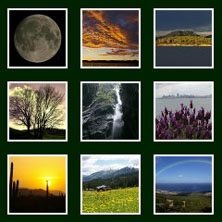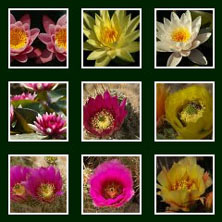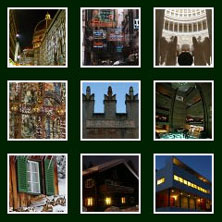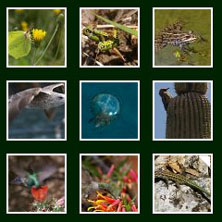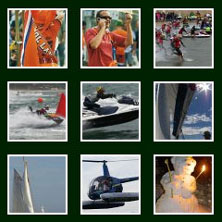A gallery of about 40 pictures from my visit to Morocco.
Morocco slide show
Monday, June 21, 2010
Sunday, June 20, 2010
Traveling through Morocco: N'kob, Val du Draa, Kasbah Tamnougalte, Marrakech
Merzouga to N’kob
After the breakfast and shower we drove to Rissani to visit the market which is held three times a week. When parking the car we were immediately surrounded by young man offering their service as a guide to lead through the market and protect us from kids and traders. We decided to take a guide called Salid. The market offers whatever people in the Tafilalet region need including fruits and vegetables, spices, dates, medicine, goods of wood, iron, recycled truck tires, carpets, tissue, cows, chicken and goats. A curiosity is the donkey parking, during the market the farmers park their donkeys on a place aside the market – the donkeys are parked and watched for a dirham or so. Or the donkey gets some new horseshoes while the farmer is on the market.
After the visit at the market we were heading eastwards to N’kob. This part of southern Morocco is less touristy than the Val du Dades. After a while the landscape changes from sand and rock desert to almost east African scenery with acacias. The area is well known for minerals and fossils, especially Trilobites. A good place to learn more about Trilobites and also to buy some is the shop of Ihmadi Mohand in Alnif, Ihmadi has a Ph. D. in geology and is a real expert on Trilobites. Be aware of fake fossils elsewhere.

In N’kob we stayed in the Ksar Jenna, a real palace in the desert. This place offers a beautiful garden and wonderful decorated rooms.
N’kob to Val du Draa
After a nice breakfast we enjoyed the nice garden of the hotel. Later one of the hotels employee took us on a tour to the nearby village, through the Palmeraie (traditional irrigated palm gardens) and a traditional Kasbah house. It’s quite impressive seeing and meeting the very friendly people here working on the fields like 3000 years ago, with simple tools and no machines. The acres are surrounded by some walls of rammed earth. On the acres wheat, corn, potatoes and vegetables are grown, at the border fruit trees like Figues, Oranges, Lemon, Almonds, Apricots and Pomegranates etc. are planted and the huge date palm trees provide some shadow to all of them.
A short ride led us to Val du Draa and the Kasbah Timidarte. The wide Draa River contrasts to the surrounding desert. We stayed one night in the restored traditional Kasbah of Timidarte. Simple but proper rooms with a shower in a very traditional guest house made out of rammed earth! We had here another nice tour through the much bigger oasis and Palmeraie. Timidarte lays on the former caravan trail connecting Timbuktu and Marrakech.
Val du Draa to Marrakech
We visited in the morning the huge Kasbah Tamnougalte, definitely a must. This huge Kasbah with only a few houses that are still inhabited consists of four parts: for the noble ones, the regular people, the Jewish part and a part for the slaves. It offers several palaces including some painted wood ceilings, mosques, and a synagogue. To visit it you have to take a guide and an entrance fee is obligatory. The Kasbah was film location for several Hollywood and European movies and there were some moments when we felt like being part of an Indiana Jones movie expecting Harrison Ford to come around the corner every moment.
From the Draa valley to Ouarzazate the road leads over some passes offering nice sights of some canyons.
At the end of our tour through Morocco we spent another day in Marrakech, this time in the southern part of the Medina. This part appeared touristier to us, it seems that you find more traveling groups in this southern part with the Bahia palace and other points of interest. As a result the traders are more aggressive than in the northern part of the medina.
After the breakfast and shower we drove to Rissani to visit the market which is held three times a week. When parking the car we were immediately surrounded by young man offering their service as a guide to lead through the market and protect us from kids and traders. We decided to take a guide called Salid. The market offers whatever people in the Tafilalet region need including fruits and vegetables, spices, dates, medicine, goods of wood, iron, recycled truck tires, carpets, tissue, cows, chicken and goats. A curiosity is the donkey parking, during the market the farmers park their donkeys on a place aside the market – the donkeys are parked and watched for a dirham or so. Or the donkey gets some new horseshoes while the farmer is on the market.
After the visit at the market we were heading eastwards to N’kob. This part of southern Morocco is less touristy than the Val du Dades. After a while the landscape changes from sand and rock desert to almost east African scenery with acacias. The area is well known for minerals and fossils, especially Trilobites. A good place to learn more about Trilobites and also to buy some is the shop of Ihmadi Mohand in Alnif, Ihmadi has a Ph. D. in geology and is a real expert on Trilobites. Be aware of fake fossils elsewhere.

In N’kob we stayed in the Ksar Jenna, a real palace in the desert. This place offers a beautiful garden and wonderful decorated rooms.
N’kob to Val du Draa
After a nice breakfast we enjoyed the nice garden of the hotel. Later one of the hotels employee took us on a tour to the nearby village, through the Palmeraie (traditional irrigated palm gardens) and a traditional Kasbah house. It’s quite impressive seeing and meeting the very friendly people here working on the fields like 3000 years ago, with simple tools and no machines. The acres are surrounded by some walls of rammed earth. On the acres wheat, corn, potatoes and vegetables are grown, at the border fruit trees like Figues, Oranges, Lemon, Almonds, Apricots and Pomegranates etc. are planted and the huge date palm trees provide some shadow to all of them.
A short ride led us to Val du Draa and the Kasbah Timidarte. The wide Draa River contrasts to the surrounding desert. We stayed one night in the restored traditional Kasbah of Timidarte. Simple but proper rooms with a shower in a very traditional guest house made out of rammed earth! We had here another nice tour through the much bigger oasis and Palmeraie. Timidarte lays on the former caravan trail connecting Timbuktu and Marrakech.
Val du Draa to Marrakech
We visited in the morning the huge Kasbah Tamnougalte, definitely a must. This huge Kasbah with only a few houses that are still inhabited consists of four parts: for the noble ones, the regular people, the Jewish part and a part for the slaves. It offers several palaces including some painted wood ceilings, mosques, and a synagogue. To visit it you have to take a guide and an entrance fee is obligatory. The Kasbah was film location for several Hollywood and European movies and there were some moments when we felt like being part of an Indiana Jones movie expecting Harrison Ford to come around the corner every moment.
From the Draa valley to Ouarzazate the road leads over some passes offering nice sights of some canyons.
At the end of our tour through Morocco we spent another day in Marrakech, this time in the southern part of the Medina. This part appeared touristier to us, it seems that you find more traveling groups in this southern part with the Bahia palace and other points of interest. As a result the traders are more aggressive than in the northern part of the medina.
Labels:
Kasbah Tamnougalte,
Marrakech,
Morocco,
N'kob,
Val du Draa
Traveling through Morocco: Gorges du Dades, Gorges du Todhra, Merzouga, Erg Chebbi
Ait Ben Haddou to Gorges du Dades
After enjoying the sunset at Ait Ben Haddou and a nice breakfast at our hotel we hit the road towards the Gorges du Dades.
The road leads mostly through desert sometimes interrupted by huge oasis along the Dades River. We stopped for the market in Skoura and in the ‘city of roses’ El-Kelaa M’Gouna. Honestly none of these little cities offered a lot to us. Although it sounds romantic when you read that El-Kelaa M’Gouna is the world capital of rose oil and rose water, it is not spectacular: an oasis with some Kasbahs nearby and a busy main street.
The landscape changes in Boulmane. Driving to the north from Boulmane leads through a beautiful green valley with several Ksars or Kasbahs, strange rock formations and then finally the very narrow canyon of the Dades River (‘Gorges du Dades’).


Gorges du Dades to Merzouga
The first stop this day leads to the Gorges du Todhra, the canyon of the Todhra river starts just a few kilometers north of the city of Tinehir with its wide oasis. We drove the Todhra valley further north, to the impressive, most narrow part of the canyon where it is quite crowded due to bus tours. Further north the landscape is nice although not so spectacular: a clear river with fresh water winds through the mountains.
After a picnic at the river we drove back to Tinehir and then through the desert towards Tinejdad. Tinejdad is a dusty desert village, but it offers two jewels: One is the beautiful garden and museum with all kind of collectibles of Said Ouadou in the center of Tinjdad on the main street. The other is also prepared by Said, some kilometers west of Tinejdad, he restored a group of mineral water springs in the middle of the desert. The area around the springs is decorated with typical goods and tools from the nomads and farm people of the region.
Further eastwards towards Erfoud the desert changes, it becomes sandier and some kilometers before Erfoud the first small dunes appear.
Merzouga – Erg Chebbi
We staid two nights in Merzouga and the Erg Chebbi region. Our hotel (Hotel Kasbah Mohayut.) offered us a nice room in the hotel for one night and arranged the tour to the desert with dromedaries (some call it just camels, although there is a difference) and the night in a tent as well.
If you don’t want to explore the dunes during the hot day, but you want to do more than just hanging around on the pool I can recommend the Dayet Sri, a big seasonal lake and the ‘Depot des Nomads’ if you are into shopping of traditional goods from a scarf through lamps to carpets.
In the late afternoon when the temperature was more moderate – even in April it was far beyond 30°C during the day – our tour with the camels started. We were a group of about 10 tourists and two guides; it took us about one and a half hour to get to the tents in the middle of the dunes. Arrived at the dunes we watched the sunset, had a simple but nice diner, enjoyed the stars in the sky and talked at the campfire. The tents were equipped with real, proper and quite comfortable beds. After the impressive sunrise we went back to the hotel were the breakfast was served and we could take a shower.
It was quite impressive to ride through the dunes and I would recommend to everybody to do such an excursion.
Next: N'kob, Val du Draa, Kasbah Tamnougalte, Marrakech
Or see the Morocco slide show for more pictures.
After enjoying the sunset at Ait Ben Haddou and a nice breakfast at our hotel we hit the road towards the Gorges du Dades.
The road leads mostly through desert sometimes interrupted by huge oasis along the Dades River. We stopped for the market in Skoura and in the ‘city of roses’ El-Kelaa M’Gouna. Honestly none of these little cities offered a lot to us. Although it sounds romantic when you read that El-Kelaa M’Gouna is the world capital of rose oil and rose water, it is not spectacular: an oasis with some Kasbahs nearby and a busy main street.
The landscape changes in Boulmane. Driving to the north from Boulmane leads through a beautiful green valley with several Ksars or Kasbahs, strange rock formations and then finally the very narrow canyon of the Dades River (‘Gorges du Dades’).


Gorges du Dades to Merzouga
The first stop this day leads to the Gorges du Todhra, the canyon of the Todhra river starts just a few kilometers north of the city of Tinehir with its wide oasis. We drove the Todhra valley further north, to the impressive, most narrow part of the canyon where it is quite crowded due to bus tours. Further north the landscape is nice although not so spectacular: a clear river with fresh water winds through the mountains.
After a picnic at the river we drove back to Tinehir and then through the desert towards Tinejdad. Tinejdad is a dusty desert village, but it offers two jewels: One is the beautiful garden and museum with all kind of collectibles of Said Ouadou in the center of Tinjdad on the main street. The other is also prepared by Said, some kilometers west of Tinejdad, he restored a group of mineral water springs in the middle of the desert. The area around the springs is decorated with typical goods and tools from the nomads and farm people of the region.
Further eastwards towards Erfoud the desert changes, it becomes sandier and some kilometers before Erfoud the first small dunes appear.
Merzouga – Erg Chebbi
We staid two nights in Merzouga and the Erg Chebbi region. Our hotel (Hotel Kasbah Mohayut.) offered us a nice room in the hotel for one night and arranged the tour to the desert with dromedaries (some call it just camels, although there is a difference) and the night in a tent as well.
If you don’t want to explore the dunes during the hot day, but you want to do more than just hanging around on the pool I can recommend the Dayet Sri, a big seasonal lake and the ‘Depot des Nomads’ if you are into shopping of traditional goods from a scarf through lamps to carpets.
In the late afternoon when the temperature was more moderate – even in April it was far beyond 30°C during the day – our tour with the camels started. We were a group of about 10 tourists and two guides; it took us about one and a half hour to get to the tents in the middle of the dunes. Arrived at the dunes we watched the sunset, had a simple but nice diner, enjoyed the stars in the sky and talked at the campfire. The tents were equipped with real, proper and quite comfortable beds. After the impressive sunrise we went back to the hotel were the breakfast was served and we could take a shower.
It was quite impressive to ride through the dunes and I would recommend to everybody to do such an excursion.
Next: N'kob, Val du Draa, Kasbah Tamnougalte, Marrakech
Or see the Morocco slide show for more pictures.
Labels:
Erg Chebbi,
Gorges du Dades,
Gorges du Todhra,
Merzouga,
Morocco
Traveling through Morocco: Marrakech and Ait Ben Haddou
This April, we traveled 12 days through Morocco. We started in Casablanca, took then the train to Marrakech where we stayed two nights. From Marrakech we did a loop with a rental car over the Atlas Mountains and through the Moroccan part of the Sahara with the following stations:
Photographing in Morocco
Before starting the description of our travel through Morocco a few words on photographing in Morocco. Morocco is an Islamic country. Although not explicit written in the Koran, since centuries the religion has a tradition to not show human beings and animals in paintings or photographs (as a modern version). This is known as Aniconism in the Islam. One of the results of this tradition leads to the fantastic ornamental work in the architecture of Morocco and Andalusia (southern Spain) which can be found especially in palaces. Although you have TV and Billboards in the Morocco of the 21st century some people still feel uncomfortable being captures on photography. Therefore you have to be careful taking pictures of people – it might happen that you try to take a picture of a crowded place in a medina and people will raise their hands to cover their face. On the other side people offer to be on a photograph and expect then a tip. And it might happen that people entertain some doubt if they should be portrayed to get a tip or not to be compliant with their belief.
Marrakech
We stayed in the Riad ‘Les Trois Mages’ which is in the northern part of the Medina, later in the trip we stayed also in the southern part - I preferred definitely to stay in the northern part, although it is a little bit farer to walk to the famous ‘Djema el Fna’. But you enter the souk from the less touristy side where it seems to be more authentic and the merchants are less ‘pushy’ in trying to sell you whatever they offer.
Things to do in one and a half days in Marrakech’s northern part of the medina:
Visit of the souk and ‘Djema el Fna’
Visit of the ‘Jardin Majorelle’, a nice tropical garden, although it’s crowdie with a lots of tourists.
Visit of the Medersa Ben Yousef (former Koran school)
Marrakech to Ait Ben Haddou
Originally I planed to have a 4x4 car, but since we were at peak season in Marrakech it was impossible to get one – at least I was to late organizing it. So we had a regular car, a mini-van with a little bit more clearance which worked well for our trip to the south and into the Sahara desert. Major streets in Morocco are usually quite good. Sometimes you might have to drive a short distance over some gravel roads to reach your final destination.
In springtime you drive from Marrakech to the Atlas Mountains through a very green and flowering landscape. Probably not what you expect thinking about Morocco. Coming to the foot of the mountains the meadows are more and more replaced by forest. Getting higher and coming closer to the Tizi-n-Tichka pass the landscape gets alpine with less and less vegetation. All along the street you see booths with minerals and fossils. The minerals are colorized in the fanciest colors! I never understood why they colorize them so unnaturally. On the southern side of the Atlas Mountains the landscape changes, rocky and colorful mountains stand in contrast to green valleys.
After five hours on the main road we arrived in Ait Ben Haddou. This Kasbah completely build by traditional rammed earth is a UNESCO world heritage and a very popular stop for tourists in this area. It might be crowded during the day. We visited it in the late afternoon after 4pm and it was not to busy. If the river carries some water locals with some donkeys offer to bring you to the other side. You have to negotiate a price. Some of the houses in Ait Ben Haddou are still in use and you might be able to visit a traditional home, when visiting a tip is expected.
Next: Gorges du Dades, Gorges du Todhra, Merzouga, Erg Chebbi
Or see the Morocco slide show for more pictures.
- Ait Ben Haddou
- Val du Dades
- Gorge du Todrah
- Merzouga and Erg Chebbi
- N’kob
- Val du Draa
Photographing in Morocco
Before starting the description of our travel through Morocco a few words on photographing in Morocco. Morocco is an Islamic country. Although not explicit written in the Koran, since centuries the religion has a tradition to not show human beings and animals in paintings or photographs (as a modern version). This is known as Aniconism in the Islam. One of the results of this tradition leads to the fantastic ornamental work in the architecture of Morocco and Andalusia (southern Spain) which can be found especially in palaces. Although you have TV and Billboards in the Morocco of the 21st century some people still feel uncomfortable being captures on photography. Therefore you have to be careful taking pictures of people – it might happen that you try to take a picture of a crowded place in a medina and people will raise their hands to cover their face. On the other side people offer to be on a photograph and expect then a tip. And it might happen that people entertain some doubt if they should be portrayed to get a tip or not to be compliant with their belief.
Marrakech
We stayed in the Riad ‘Les Trois Mages’ which is in the northern part of the Medina, later in the trip we stayed also in the southern part - I preferred definitely to stay in the northern part, although it is a little bit farer to walk to the famous ‘Djema el Fna’. But you enter the souk from the less touristy side where it seems to be more authentic and the merchants are less ‘pushy’ in trying to sell you whatever they offer.
Things to do in one and a half days in Marrakech’s northern part of the medina:
Visit of the souk and ‘Djema el Fna’
Visit of the ‘Jardin Majorelle’, a nice tropical garden, although it’s crowdie with a lots of tourists.
Visit of the Medersa Ben Yousef (former Koran school)
Marrakech to Ait Ben Haddou
Originally I planed to have a 4x4 car, but since we were at peak season in Marrakech it was impossible to get one – at least I was to late organizing it. So we had a regular car, a mini-van with a little bit more clearance which worked well for our trip to the south and into the Sahara desert. Major streets in Morocco are usually quite good. Sometimes you might have to drive a short distance over some gravel roads to reach your final destination.
In springtime you drive from Marrakech to the Atlas Mountains through a very green and flowering landscape. Probably not what you expect thinking about Morocco. Coming to the foot of the mountains the meadows are more and more replaced by forest. Getting higher and coming closer to the Tizi-n-Tichka pass the landscape gets alpine with less and less vegetation. All along the street you see booths with minerals and fossils. The minerals are colorized in the fanciest colors! I never understood why they colorize them so unnaturally. On the southern side of the Atlas Mountains the landscape changes, rocky and colorful mountains stand in contrast to green valleys.
After five hours on the main road we arrived in Ait Ben Haddou. This Kasbah completely build by traditional rammed earth is a UNESCO world heritage and a very popular stop for tourists in this area. It might be crowded during the day. We visited it in the late afternoon after 4pm and it was not to busy. If the river carries some water locals with some donkeys offer to bring you to the other side. You have to negotiate a price. Some of the houses in Ait Ben Haddou are still in use and you might be able to visit a traditional home, when visiting a tip is expected.
Next: Gorges du Dades, Gorges du Todhra, Merzouga, Erg Chebbi
Or see the Morocco slide show for more pictures.
Labels:
Ait Ben Haddou,
Marrakech,
Morocco,
travel
Subscribe to:
Posts (Atom)













